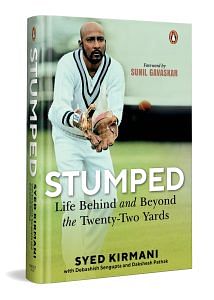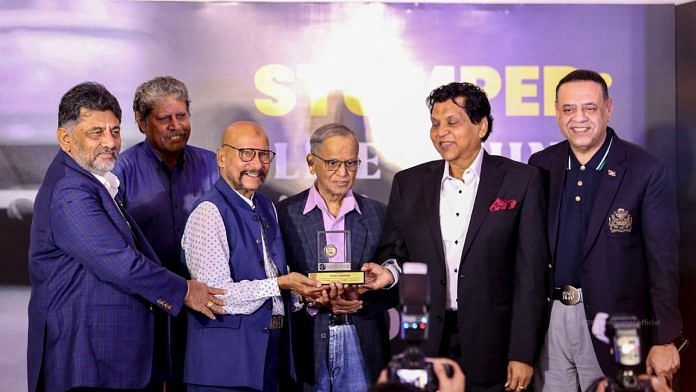I wouldn’t go into the details of the movie, but if any one of you is interested to see my heroics in my first attempt at acting, then you can watch the entire movie on YouTube. My photos were splashed on the media centre spreads doing karate and in other poses. Despite the failure of the film, I became quite popular in Australia. So wherever I went to parties or elsewhere, Australian fans would call me Kojak. Kojak was the protagonist of a very popular American action crime and drama television series of the same name. I was always very social and despite my popularity, I never showed any arrogance or an inflated ego. My upbringing had taught me to remain rooted.
Soon, in a match played at Brisbane, I took a brilliant catch diving on my right side off the flick of Alan Border. That catch was adapted by Channel 9 as the opening shot before broadcasting every match throughout our series in Australia.
Due to my popularity, my career was on the rise and this created a feeling of envy in many. Our team manager spoke to the media the next day and to my utter surprise, he announced that I was injured and had to go back home. There was no injury, only a small limp after taking Alan Border’s catch on the leg side, but it was used as an excuse to drop me. The second wicketkeeper on the tour, Kiran More replaced me. Perhaps, they were tired of seeing me and had had enough of me. There was no reason to drop me, and it was clear that they did not want me any more.
I was dropped like a hot brick again and that was the end of my career. I was in very good form and performing consistently well when they dropped me unceremoniously. I was not allowed to complete 100 test matches; moreover, my total wickets remained stalled at 198, just two short of 200. That would have been an individual record. But they said, enough is enough and no new record should be made in his name. Had I continued to play, I would have gone well past the 300 test wickets.
I was forced to sit out for the rest of the matches. The 1986 tour of Australia was an end to my career. Between 1986–93, I made every effort to stage a comeback and honour my country, but it was as if they had put a huge lock on my career and thrown the key to sea. And eventually, in 1993, I gave up and asked for a benefit from the Board of Control for Cricket in India. It was granted to me against a home series opposite New Zealand. Team India was playing under the captaincy of Mohammed Azharuddin then. In the year 1994–95, I was forced to go to Bombay with a begging bowl for my benefit. You see, at that time BCCI was honouring the cricketers who had played 100 test matches. How could I possibly get my benefit game?
At that time, I approached the secretary of the BCCI and the president of the Karnataka State Cricket Association (KSCA) and his rude and arrogant response really stumped me. He told me that if I had played ninetyone or more matches, I would get the benefit. Why did he mention ninety-one matches? How did ninety-one suddenly become a magic number? Well! He said this to me because of Gundappa Vishwanath, my dear friend and SBI colleague from Karnataka, perhaps also the most stylish player between late 1960s and 1970s and a charming and humorous person. I am yet to see a batsman play a late cut and a square cut like Vishy till date. He had played ninety-one test matches and had announced his retirement. Apparently, the secretary didn’t want me to exceed his record and kept insisting that only if I played ninety-one or more test matches could I get my benefit.
I had no choice but to go to the next elected body of BCCI. Mr I.S. Bindra from Punjab was the president of BCCI at that time; how can I forget his name! Mr Jagmohan Dalmia had taken over as the secretary. He was also the president of Cricket Association of Bengal (CAB). I met them both and repeated what the secretary of KSCA had told me. ‘I was told that the benefit is only for players who have played 100 or more test matches. Then Sir, how was Gundappa Vishwanath given his benefit with only ninety-one matches? And what is the difference between eighty-eight and ninety-one matches?’
So, on that basis, they assured me that they would grant me a benefit. I had played forty-nine ODIs and eighty-eight test matches. They clubbed them together and counted it as 100 test matches. It was a great gesture from Mr Bindra and Mr Dalmia to grant me the board’s benefit.
I had been very treated badly by KSCA, where I was forced to beg, and I didn’t want my benefit to be played there. The best place for me was Bombay, my hunting ground the Wankhede Stadium. I had met the expectations of one and all whenever I had performed at this stadium. And that’s how I went to Mr Raj Singh Dungarpur who was the president of Cricket Club of India (CCI) and the chairman of the Selection Committee. When I approached him, he told me that they could make me an offer of Rs 25 lakh.
I was taken aback. Other Indian cricketers at that time were beneficiaries of Rs 1 crore, and I am talking of the 1990s. Mr Dungarpur said, ‘Kiri this is an ordinary match. We will not get a huge crowd for the New Zealand–India match. So we can only offer you Rs 25 lakh. So, if it is agreeable to you then we will have the last match played at CCI instead of Wankhede Stadium.’
CCI had a beautiful historic cricket ground and all matches were played on these grounds before the Wankhede Stadium was built. The Wankhede Stadium was built after a conflict between CCI and Bombay Cricket Association (BCA) at the behest of Mr S.K. Wankhede, a politician and the secretary of the Mumbai Cricket Association. Since then, Wankhede has been the main venue for international cricket matches in Mumbai.
Having no choice, I accepted whatever was offered to me. I was not allowed to sell the tickets, nor allowed to publish my brochure or sell the T-shirts on the ground. In an effort to dispel his fears of a low turnout, I told Raj bhai, ‘This match is going to be the decider between India and New Zealand. So obviously there will be a crowd to see the match. And cricket fans love me. I assure you, it will be a sell-out crowd.’ He replied saying, ‘We will see, and if it is a sell-out then we may consider something more.’
My prediction proved to be right. The last match was indeed the series decider and one week before the match, all tickets were sold out. This time around, I spoke to Raj bhai once again and he told me, ‘Let’s see after the collection what more we can do for you.’ All Raj bhai could manage was an additional Rs 5 lakh for a total of Rs 30 lakh. But this is not the end of the story. There is something very important that took place at CCI.
I was staying at CCI in the main club room. Suddenly, in the middle of the night, there was lots of noise outside the room and on the ground. There was an event management group outside and they were talking about the hoardings of Manickchand gutka. Over the chaos that prevailed, I later came to know through reliable sources that Raj bhai had sold my benefit match for a sum of Rs 85 lakh . . . oops! Yes, you read it right, the match that was supposed to be my benefit match had been sold for a much higher price than what I was offered after much persuasion and cajoling. The event management group had ensured that the whole stadium was covered with Manickchand Gutka hoardings, and a total of Rs 1 crore had been taken from Manickchand Gutka for doing the same. I was appalled and heartbroken to witness such a level of corruption and complete contempt for my contribution to Indian cricket.
I remember after the match, Ravi Shastri had come down from the commentary box to take my interview. I remember him saying, ‘Kiri, you must have brought a big suitcase with you to carry the moolah from your benefit match.’ I couldn’t help but laugh at the question and replied, ‘I have brought a small attachee (small, handheld suitcase) with me, and I do not know who has the big suitcase filled with moolah.’ I think Ravi would have gotten the message.
 This excerpt from ‘Stumped: Life Behind and Beyond the Twenty-Two Yards’, written by Syed Kirmani with Debashish Sengupta and Dakshesh Pathak, has been published with permission from Penguin Random House India.
This excerpt from ‘Stumped: Life Behind and Beyond the Twenty-Two Yards’, written by Syed Kirmani with Debashish Sengupta and Dakshesh Pathak, has been published with permission from Penguin Random House India.






